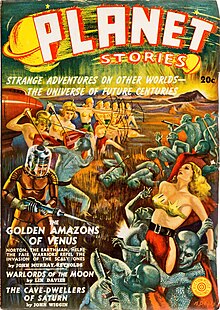
Back Venus en la ficción Spanish Vénus dans la fiction French Venere in fiction Interlingua Venere nella fantascienza Italian Венера в культуре Russian 虛構作品中的金星 Chinese

The planet Venus has been used as a setting in fiction since before the 19th century. Its opaque cloud cover gave science fiction writers free rein to speculate on conditions at its surface—a "cosmic Rorschach test", in the words of science fiction author Stephen L. Gillett. The planet was often depicted as warmer than Earth but still habitable by humans. Depictions of Venus as a lush, verdant paradise, an oceanic planet, or fetid swampland, often inhabited by dinosaur-like beasts or other monsters, became common in early pulp science fiction, particularly between the 1930s and 1950s. Some other stories portrayed it as a desert, or invented more exotic settings. The absence of a common vision resulted in Venus not developing a coherent fictional mythology, in contrast to the image of Mars in fiction.
When included, the native sentient inhabitants, Venusians, were often portrayed as gentle, ethereal and beautiful. The planet's associations with the Roman goddess Venus and femininity in general is reflected in many works' portrayals of Venusians. Depictions of Venusian societies have varied both in level of development and type of governance. In addition to humans visiting Venus, several stories feature Venusians coming to Earth—most often to enlighten humanity, but occasionally for warlike purposes.
From the mid-20th century on, as the reality of Venus's harsh surface conditions became known, the early tropes of adventures in Venusian tropics mostly gave way to more realistic stories. The planet became portrayed instead as a hostile, toxic inferno, with stories changing focus to topics of the planet's colonization and terraforming, although the vision of tropical Venus is occasionally revisited in intentionally retro stories.